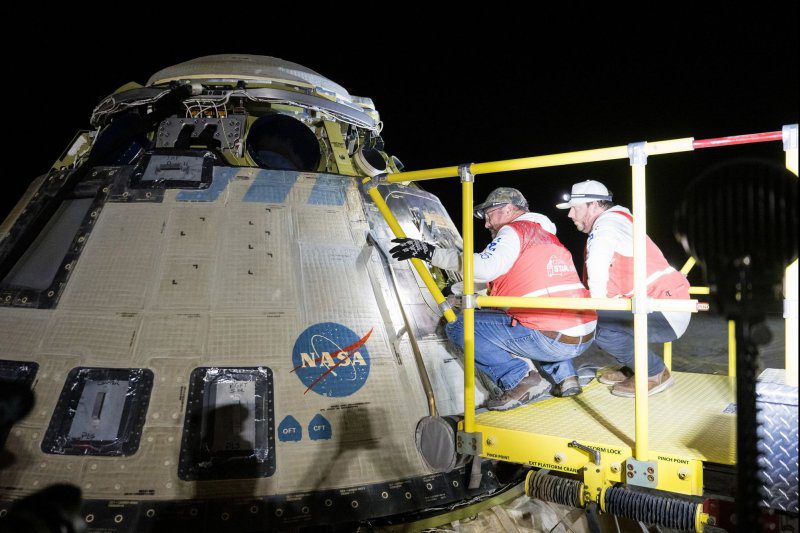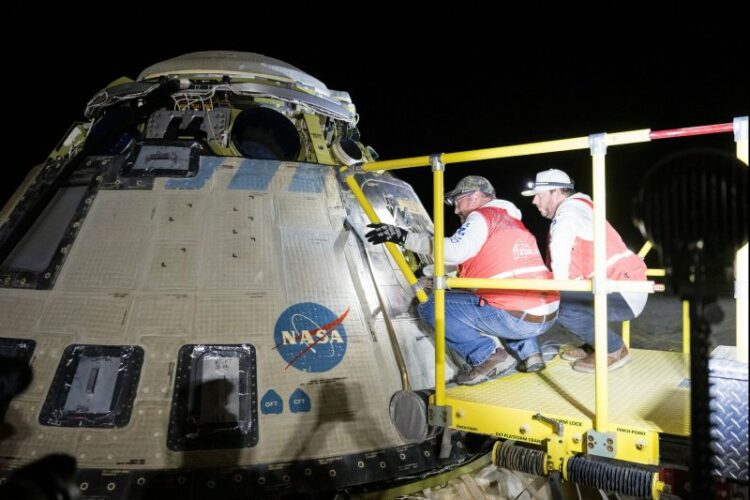
1 of 6 | Boeing and NASA teams work around NASA’s Boeing Starliner spacecraft after it landed uncrewed on Friday at White Sands, N.M. NASA Photo by Aubrey Gemignani/UPI | License Photo
Sept. 6 (UPI) — The uncrewed Boeing Starliner successfully landed in New Mexico late Friday after departing six hours earlier from the International Space Station.
The capsule left behind two astronauts — Butch Wilmore and Suni Williams — who must now remain in the station until February for a return home on a SpaceX capsule. NASA decided problems with Starliner’s thrusters and leaking helium made it too risky of a return with humans.
Starliner landed at White Sands Space Harbor at 10:01 p.m. MDT. Ground crews welcomed the capsule with plans to return it to Florida where it launched on June 6.
The autonomous undocking from the ISS was carried out as scheduled at 4:04 p.m. MDT after the craft was unhooked from the the forward module of the station. It slowly backed away while executing a series of 12 “breakout burns” over a 5-minute span, driving it farther away from the station while flying over central China.
The Starliner oriented itself as it plunged into the Earth’s atmosphere while still traveling at more than 17,000 miles per hour. The atmosphere was more than 3,000 degrees Fahrenheit.
Three parachutes and thrusters slowed the craft and airbags were deployed.
Boeing is hoping to earn certification for future flights for NASA. NASA wants to rely on another company than Space-X and Russia’s Soyuz for Space Station missions.
Starliner is the first U.S-made capsule to land on the ground instead of splashing down in the ocean.
“It’s important to remember this was a test mission,” Joel Montalbano, NASA’s deputy associate administrator for space operations, said at a news conference after Starliner had landed.
“I want to recognize the work the Starliner teams did to ensure a successful and safe undocking, deorbit, reentry and landing,” Mark Nappi, vice president and program manager of Boeing’s Commercial Crew Program, said. “We will review the data and determine the next steps for the program.”
NASA determined that the capsule’s propulsion system appeared stable, but the thruster issues posed too much of a risk for Starliner to return with a crew.
“If we’d had a model that would have predicted what we saw tonight perfectly, yeah, it looks like an easy decision to go say we could have had a crewed flight – but we didn’t have that,” Stitch said.
“From a human perspective, all of us feel happy about the successful landing,” he said. “But then there’s a piece of us, all of us, that we wish it would have been the way we had planned it. We had planned to have the mission land with Butch and Suni on board.”
Its flight path went over parts of northern Mexico and southwestern New Mexico, making it visible in the night sky over those areas depending on cloud cover.
On June 5, the Boeing spacecraft took off on its first crewed flight, transporting NASA Wilmore and Williams to the space station. However, as it approached the orbiting laboratory, NASA and Boeing identified helium leaks and noted malfunctions with its reaction control thrusters.
Five of Starliner’s 28 “reaction control system” thrusters abruptly stopped working en route to the space station. Four were recovered and at least one stayed out of service for the entire mission.
NASA announced last month that out of concerns for the safety of Wilmore and Williams, they will remain aboard the ISS until February while Starliner is autonomously returned to Earth without a crew.
Wilmore and Williams are now scheduled to return home aboard the SpaceX Dragon spacecraft with two other crew members assigned to NASA’s SpaceX Crew-9 mission.
“It is time to bring Calypso home,” Williams said to mission control Friday evening. “You have got this. We have your backs, and you’ve got this. Bring her back to Earth.”
Its service module up during re-entry over the southern Pacific Ocean, while its heat shield was jettisoned at approximately 30,000 feet, exposing a series of drags and parachutes.
Instead, the thruster issues became the latest major setback for Boeing’s Starliner program, which even before the launch was more than $1.5 billion over budget and years behind schedule. An uncrewed test flight to the space station, which NASA required of Boeing before its spacecraft could carry astronauts, also went awry the first time, and the company had to repeat it in 2022.

A United Launch Alliance Atlas V rocket carries the Boeing Starliner capsule on its maiden crewed flight from Complex 41 at Cape Canaveral Space Force Station in Florida on June 5, 2024. Photo by Joe Marino/UPI | License Photo
Source link : http://www.bing.com/news/apiclick.aspx?ref=FexRss&aid=&tid=66dcaf306fa34737823cb835cd039d76&url=https%3A%2F%2Fwww.upi.com%2FScience_News%2F2024%2F09%2F06%2FUncrewed-Starliner-undock-ISS-Friday-evening-land-6-hours-later%2F6441725647280%2F&c=13870502383798169931&mkt=en-us
Author :
Publish date : 2024-09-06 09:07:00
Copyright for syndicated content belongs to the linked Source.
